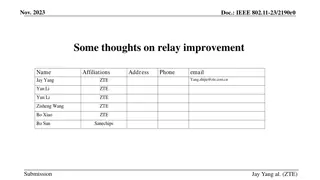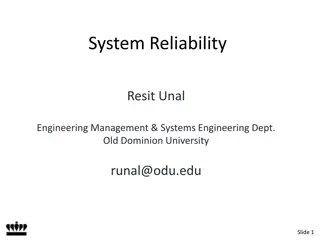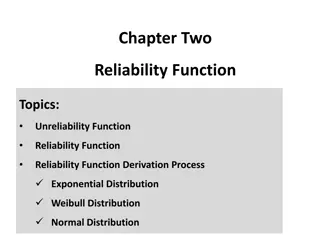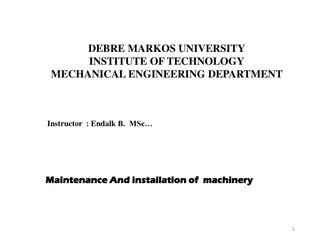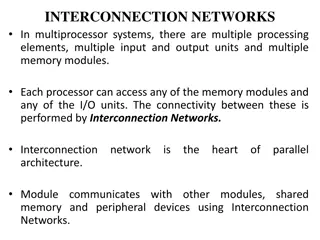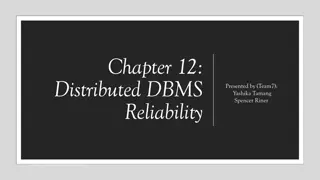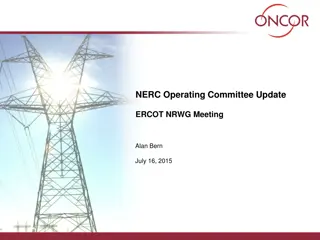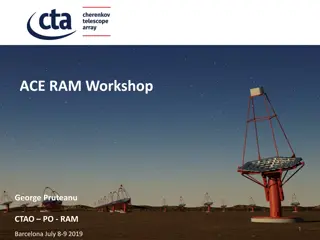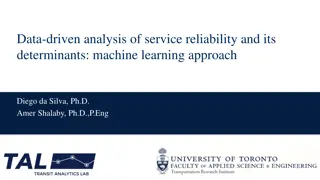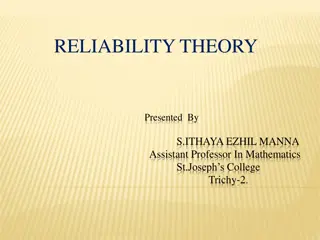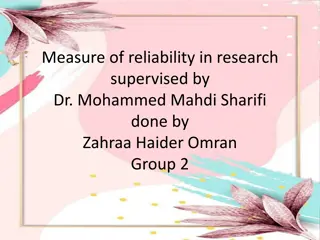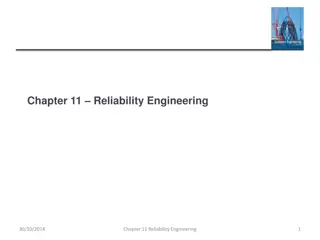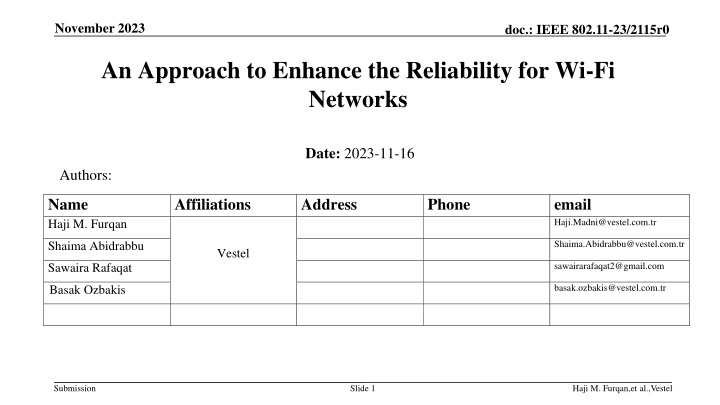
Enhancing Wi-Fi Network Reliability with Intelligent Data Transmission
Explore how Vestel's approach leverages MU-MIMO and OFDMA to enhance Wi-Fi network reliability and reduce latency through intelligently designed redundant data transmission. The method optimizes data stream segments to mitigate deep-faded sub-channels, improving overall network performance. Discover the steps involved in constructing and broadcasting the intelligently designed data stream to achieve enhanced reliability in MU-MIMO systems.
Download Presentation

Please find below an Image/Link to download the presentation.
The content on the website is provided AS IS for your information and personal use only. It may not be sold, licensed, or shared on other websites without obtaining consent from the author. If you encounter any issues during the download, it is possible that the publisher has removed the file from their server.
You are allowed to download the files provided on this website for personal or commercial use, subject to the condition that they are used lawfully. All files are the property of their respective owners.
The content on the website is provided AS IS for your information and personal use only. It may not be sold, licensed, or shared on other websites without obtaining consent from the author.
E N D
Presentation Transcript
November 2023 doc.: IEEE 802.11-23/2115r0 An Approach to Enhance the Reliability for Wi-Fi Networks Date: 2023-11-16 Authors: Name Haji M. Furqan Affiliations Address Phone email Haji.Madni@vestel.com.tr Shaima.Abidrabbu@vestel.com.tr Shaima Abidrabbu Vestel Sawaira Rafaqat sawairarafaqat2@gmail.com Basak Ozbakis basak.ozbakis@vestel.com.tr Submission Slide 1 Haji M. Furqan,et al.,Vestel
November 2023 doc.: IEEE 802.11-23/2115r0 Introduction (1/2) The UHR study group (current IEEE 802.11 bn) was founded to look into the solutions that could enhance throughput, enhance reliability, reduce latency, and improve power consumption [1]. Several technologies have been proposed for consideration in UHR, including Multi-AP [2-5] Preemption [6] mm-Wave MLO [7-8] MIMO enhancements [9] Power efficiency [10-11] Redundant transmission [12] Submission Slide 2 Haji M. Furqan,et al.,Vestel
November 2023 doc.: IEEE 802.11-23/2115r0 Introduction (2/2) Multi-user MIMO (MU-MIMO) and Orthogonal Frequency Division Multiple Access (OFDMA) are pivotal for enhancing overall network performance. UHR study group aims at improving reliability and reducing latency in such systems. One effective method for improving reliability and reducing latency is through redundant transmission [12]. However, challenges still exist concerning the type of data to be transmitted redundantly and the appropriate transmission method. In this presentation, a mechanism is introduced that leverages the capabilities of MU- MIMO and OFDMA to enhance reliability and reduce latency based on intelligently design redundant version of data. Submission Slide 3 Haji M. Furqan,et al.,Vestel
November 2023 doc.: IEEE 802.11-23/2115r0 Proposed Method Enhancing Reliability in MU-MIMO Systems: Supplementing conventional downlink data stream with an intelligently designed data stream that is broadcasted to users. Transmission Facilitation: The intelligently designed data stream optimizes the transmission of users' data stream segments, particularly those prone to encountering deep-faded sub-channels. Simultaneous Improvement: Intuitively the proposed approach enhances reliability and reduces the latency in MU-MIMO systems. Submission Slide 4 Haji M. Furqan,et al.,Vestel
November 2023 doc.: IEEE 802.11-23/2115r0 Transmitter Side The construction of the intelligently designed data stream follows these steps: For any user, the data corresponding to indices of subcarriers that will face deep-faded sub-channels is selected and incorporated into the intelligently designed data stream. The data from different users is arranged in a concatenated form within the intelligently designed data stream. Afterwards, the intelligently designed data stream is broadcasted in conjunction with conventional transmission, utilizing different power levels. Submission Slide 5 Haji M. Furqan,et al.,Vestel
November 2023 doc.: IEEE 802.11-23/2115r0 Receiver Side (case 1) The power of intelligent stream is lower than other streams. The following are the steps: 1. Users can decode their data from the received signal, employing conventional MU-MIMO reception techniques. If a user aims to enhance reliability, it will undertake the following steps: a) Extraction of Deep-Faded Sub-channel Data:The user extracts data from the received signal based on the indices of subcarriers corresponding to deep-faded sub-channels. 2. b) Intelligent Broadcasted Data Stream Retrieval:Subsequently, the user retrieves its corresponding segment from the intelligently designed data stream using successive interference cancellation (SIC). Maximum Ratio Combining:Finally, the user combines the data extracted in steps (a) and (b) using Maximum Ratio Combining. c) Submission Slide 6 Haji M. Furqan,et al.,Vestel
November 2023 doc.: IEEE 802.11-23/2115r0 Receiver Side (case 2) The power of intelligent stream is higher than other streams. The following are the steps: 1. Users begin by detecting the intelligent data stream. 2. After detection, they extract their conventional data stream using successive interference cancellation (SIC). 3. Users then choose data symbols from the conventional stream that correspond to deep-faded sub-channels. 4. Finally, the data from step (3) is combined with the corresponding segment from the intelligently designed data using Maximum Ratio Combining. Submission Slide 7 Haji M. Furqan,et al.,Vestel
November 2023 doc.: IEEE 802.11-23/2115r0 Conclusions This presentation presents a novel method for increasing reliability by supplementing the conventional downlink data stream with an intelligently designed data stream that is broadcast to users. In MU-MIMO systems, the proposed technique improves reliability while decreasing latency. This method is especially effective in mitigating reliability degradation caused by data transmitted over deep-faded sub-channels because the transmission of such data in the intelligently designed data stream, combined with combining at the receiver, serves to improve overall reliability. Submission Slide 8 Haji M. Furqan,et al.,Vestel
November 2023 doc.: IEEE 802.11-23/2115r0 Straw Poll Are you in favor of supporting the new concept of transmission for MU MIMO networks in TGbn? Yes: No: Abstain: Submission Slide 9 Haji M. Furqan,et al.,Vestel
November 2023 doc.: IEEE 802.11-23/2115r0 References [1] 11-22/708 Beyond be - Next Step . [2] 11-22/1516 Considerations on Multi-AP Coordination [3] 11-22/1530 Multi AP coordination for next-generation Wi-Fi [4] 11-22/1567 C-OFDMA throughput analysis in various mesh backhaul scenarios [5] 11-22/1556 Multi-AP Coordination for Low Latency Traffic Delivery [6] 11-22/1393 Latency Reduction Scheme for UHR [7] 11-22/1395 Thoughts on high frequency band [8] 11-22/1595 Some questions to answer in the SG [9] 11-22/1649 MIMO interference suppression for enhanced reliability [10] 11-22/1790 Green AP and resilience requirements for home networks [11] 11-22/1414 Low Power Listening Mode [12] 11-21/1205r0 Redundant Transmission for Enhanced Reliability and Reduced Latency Submission Slide 10 Haji M. Furqan,et al.,Vestel

